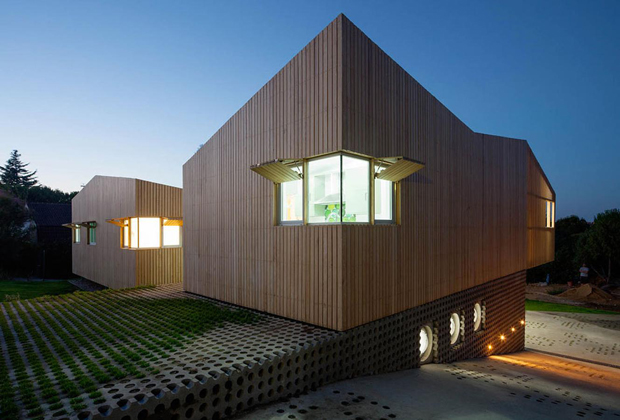Craft vs. prefab: Why stick-built will stick around


What's the real problem facing prefab construction today?
It's not any failing of prefabricated building manufacturers, that much is plain: almost daily they bring us new, genius techniques in modular, pre-made building approaches. Rather, the challenge centers on the long-term, perhaps permanent conflict between what architecture is -- and what manufacturing offers.
Architecture is about craft, to use today's zeitgeist notion. It's about making models, as Michael Maltzan of Los Angeles argues, and about turning drawing and sketching into building ideas, as Philadelphia's Dan Kelley contends. Craft is seen as synonymous with success: "Craft is about precision and perfection and elegant design," writes North Carolina architect Jody Brown in ArchDaily. "Craft is about that moment of clarity."
Perhaps prefab is the antithesis of craft.
Granted, there are other issues. But cost is certainly NOT among them, even in the light of a recent exposé in The New York Times (and analyzed here on SmartPlanet). In this case, a home designed by prefab maven Rocio Romero went to bid, and the low-ball builder was chosen. Of course, the project was bid too low, so it eventually overran the allotted budget, ending up 45 percent more costly than expected.
This isn't the fault of prefab, the prospect of which had everyone snickering. No, it was due to unwise contracting.
Cost and schedule?
For the Romero project in the Times, the problem was that the client used old-school low-bid selection. This issue could happen with any kind of house design. That's why not a single architect I know raised an eyebrow.
Maybe it's something else. Is there a control issue with prefab?
Possibly. Prefabricated and pre-engineered assemblies offer great control of quality and dimensional tolerances. They speed up work on site. The methods cut into the messy side of trade labor. It's true, making something in the shop is much more precise than building it with sticks on a windy, cold and wet construction site. Maybe architects and contractors resent that loss of personal control, and resist it?
I doubt it. Architecture has always relied on some factory-made components. Pre-engineered mega-panels are just a high-tech version of molded clay brick.
The issue is surely not the client, either.
Innovations in delivery
Builders and developers believe in innovation and top-down control. Some envisage their "product" as the last stop on some grand assembly line. Yet, their interest in prefab, modular systems ends where the negotiation breaks down, as happened with Forest City Ratner and Kullman recently. (Reports have it that the two fought hard over a deal to build the Atlantic Yards residential towers, and parted ways when Forest City hired away the modular fabricator's key people.)
A few corporate homebuilders see their empires extending to the means of production, but this pipe dream is rare. The money people just want it cheaper, and of a quality that the market will find acceptable.
It's their architects who are dangerous, in many cases. While most don't share the assembly-line vision, some offer prefabrication as a design end or a means to solve the world's ills. Prefab rebuilds after the storm! Prefab housing for the homeless! Some firms have "partnered" with manufacturers to market high-end product lines bearing their signature. How can prefab take center stage in a design philosophy? It can't unlock some unique aesthetic future by itself.
These one-off experiments only prove that the means of manufacture are incidental to good architecture.
Which brings up another key point in the prefab versus. stick-built debate: What of aesthetics?
In Architect magazine, Ned Cramer has made the point that prefab is "only half the battle," which may have been a generous apportioning. He points to "universal design flaws" that transcend the prefab versus stick-built question: "awful proportions, awkward layouts, ungainly massing." Add to that list poor site planning and sprawl, and the point is easily made: Our world improves little just because prefab building kits are widely available.
Aesthetics and craft
We still need the aesthetic visionary to make those manufactured components work in concert.
In fact, the most important current in architectural thinking over the past few years is about the opposite of industrialized, off-site construction.
It's about craft -- and craft is the way architects control quality first from a distance, using drawings and specifications, and then how they extend that control to the point of construction, using their broad knowledge of building.
Manufactured housing is a World War I-era technology. It's about mass production and off-the-shelf solutions, not about solving the super-localized, unique conditions that make every building a special problem.
Prefab: One of many
To solve those problems, the architect chooses from a raft of tools and techniques, products and approaches. The architect analyzes site, program, form and a thousand other inputs. Energy use, occupant health and visual impact are all evaluated as part of the complex decision-making that is architectural craft.
The likelihood is great that one or more manufactured solutions will contribute to the outcome. But the idea that a manufactured solution will predominate is very slim -- it could work in some situations, where the benefits of prefabrication and project needs overlap considerably.
So prefab is not poised to revolutionize architecture, ever. Sorry.
With its incremental successes over the last few years, we're seeing how prefab can rise hit a nice, healthy plateau, reinforcing its permanent role as an ally of craft -- not its proxy.
This post was originally published on Smartplanet.com